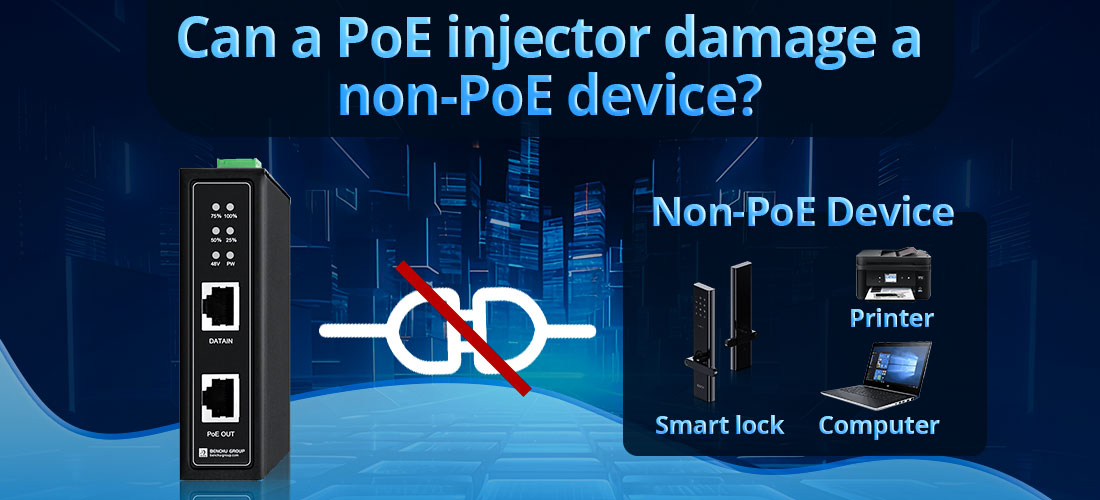
نعم ، يمكن أن يؤدي حاقن Poe إلى إتلاف جهاز غير بوي ، ولكن فقط إذا تم استخدام حاقن غير متوافق. يعتمد المخاطر على ما إذا كان الحاقن نشطًا (متوافق مع IEEE) أو السلبي.
1. فهم كيفية عمل حقن بو
A حاقن بو يزود الطاقة عبر كابل Ethernet ، مما يسمح للأجهزة بتلقي كل من الطاقة والبيانات من خلال اتصال واحد. يرسل الحاقن جهد التيار المستمر من خلال دبابيس إيثرنت محددة مع الحفاظ على نقل البيانات القياسي على المسامير المتبقية.
حقن POE النشط (IEEE 802.3AF/AT/BT متوافق)
--- استخدم بروتوكول المصافحة لاكتشاف ما إذا كان الجهاز المتصل يدعم POE.
--- لا ترسل الطاقة إذا كان الجهاز غير بوي ، مما يضمن السلامة.
--- آمن للاستخدام مع كل من أجهزة Poe و Non-Poe.
حقن Poe السلبي (غير قياسي)
--- أرسل السلطة دائمًا دون تفاوض.
--- يمكن تقديم 24 فولت أو 48 فولت أو أعلى من توافق الجهاز.
--- خطر الإضرار بالأجهزة غير البيرات إذا كان الجهد غير متوافق.
2. متى يمكن لحاقن POE تلف جهاز غير بوي؟
يمكن أن يتلف جهاز غير بوي (على سبيل المثال ، كمبيوتر أو طابعة أو مفتاح قياسي دون دعم POE) إذا كان متصلاً بحاقن POE السلبي أو حاقن غير متوافق يجبر الجهد على منفذ Ethernet.
السيناريوهات التي يمكن أن يحدث فيها الضرر
| سيناريو | مستوى المخاطر | توضيح |
| حاقن POE النشط (IEEE 802.3AF/AT/BT) إلى جهاز غير بوي | لا خطر | يكتشف حقن POE مع تكنولوجيا المصافحة عدم التوافق ولا ترسل الطاقة. |
| حاقن Poe السلبي (دائمًا على الطاقة) إلى جهاز غير بوي | مخاطر عالية | يوفر الجهد الثابت (على سبيل المثال ، 24V أو 48V) ، والذي يمكن أن يحرق منفذ Ethernet أو الدوائر الداخلية. |
| حاقن بو غير قياسي (علامات تجارية رخيصة غير منظمة) | معتدلة إلى عالية المخاطر | قد توفر جهدًا غير صحيح دون التفاوض ، والمخاطرة بالتحميل الزائد وارتفاع درجة الحرارة للجهاز. |
| حاقن بو مع Poe Splitter إلى جهاز غير بوي | آمن | يستخلص Poe Splitter البيانات فقط ويزيل الطاقة ، مما يسمح بالاستخدام الآمن مع الأجهزة غير الوعرة. |
3. كيف تحمي حقن POE النشطة الأجهزة
تتضمن حقن POE النشطة المتوافقة مع IEEE (802.3AF ، 802.3AT ، 802.3BT) عملية تفاوض للطاقة:
--- مرحلة الكشف: يرسل الحاقن نبضة جهد صغيرة للتحقق مما إذا كان الجهاز يستجيب بتوقيع POE.
--- مرحلة التصنيف: إذا كان الجهاز متوافقًا مع POE ، فإن الحاقن يعين مستوى الطاقة الصحيح.
--- توصيل الطاقة: فقط بعد التحقق ، يرسل الحاقن الطاقة عبر الكابل.
--- آلية الحماية: إذا لم يتم اكتشاف توقيع POE ، فلا يتم إرسال الطاقة ، مما يضمن سلامة الأجهزة غير البير.
لن يضر حقن POE النشط أبدًا جهازًا غير بوي لأنه لا يوفر الطاقة ما لم يطلب الجهاز ذلك.
4. كيفية منع التلف عند استخدام حاقن بو
استخدم حاقن POE المتوافق مع IEEE
--- اختار دائمًا الحقن التي تتبع معايير IEEE 802.3AF/AT/BT.
--- تجنب الحقن الرخيصة أو العامة التي قد تفتقر إلى التفاوض السليم للطاقة.
تحقق من توافق جهازك
--- تحقق مما إذا كان جهازك هو بو أو غير بوي قبل توصيله بالحاقن.
--- إذا كان الجهاز غير بوي ، فلا تستخدم حاقن POE السلبي.
استخدم فاصل Poe للأجهزة غير الضيقة
--- يفصل فاصل Poe الطاقة والبيانات ، مما يسمح للجهاز غير بوي بتلقي البيانات بأمان فقط.
--- يستخلص الخائن الطاقة ويحولها إلى إخراج DC منفصل للأجهزة التي تتطلب الطاقة ولكنها لا تدعم POE.
تجنب حقن Poe السلبي ما لم يكن ذلك ضروريًا
--- استخدم فقط حقن POE السلبي مع الأجهزة المصممة خصيصًا للتعامل مع POE السلبي.
--- إذا لم تكن متأكدًا ، فلا تقوم بتوصيل جهاز غير بوي بحاقن POE السلبي.
5. الخلاصة: هل يمكن لحاقن POE تلف جهاز غير بوي؟
حقن POE النشطة (IEEE 802.3AF/AT/BT المتوافقة) آمنة ولن ترسل الطاقة إلى جهاز غير بوي.
يمكن أن تتسبب حقن POE السلبي في إتلاف الأجهزة غير البيرات لأنها توفر الطاقة دون التحقق من التوافق.
تحقق دائمًا من التوافق واستخدم Poe Splitters عند توصيل الأجهزة غير Poe بالشبكات التي تعمل بزاوية POE.
التوصية: إذا لم تكن متأكدًا مما إذا كان الجهاز يدعم POE ، فاستخدم دائمًا حاقن POE نشط معتمد للقضاء على خطر الضرر.